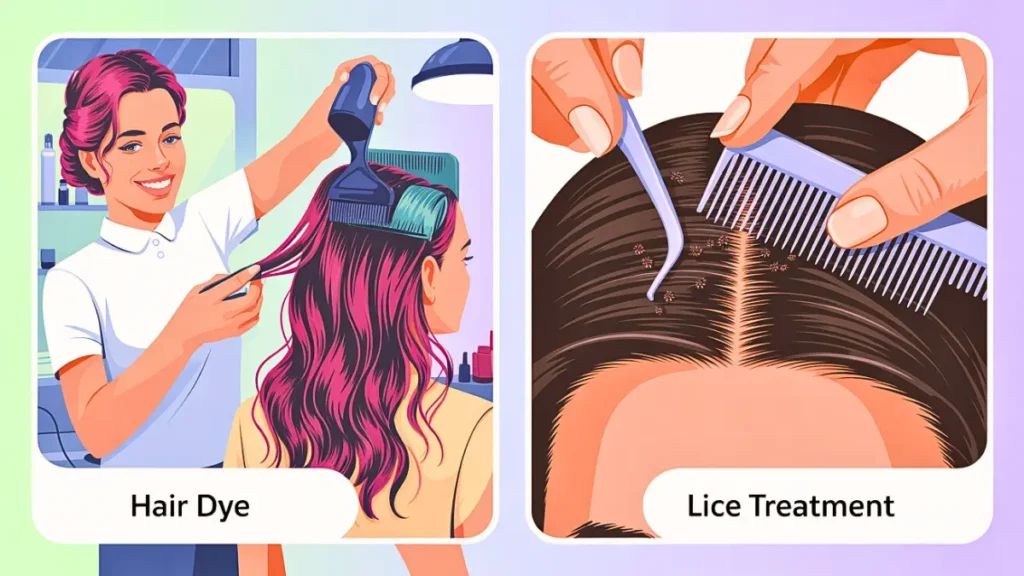Introduction
Dealing with an active infestation of head lice can be stressful, especially if you’re considering colouring your hair. The terms hair dye and lice often appear together in online searches, driven by questions like “Does hair dye kill lice?” or “When can I dye my hair after lice treatment?” This post clarifies the science and offers actionable advice.
What Are Head Lice?
Life Cycle and Identification
Head lice are tiny parasitic insects that live on the scalp and feed on human blood. They lay eggs (nits) close to the scalp, which hatch in about 7–10 days, perpetuating the infestation CDC. Nits appear as small white or yellowish specks firmly attached to hair shafts, most commonly near the ears and nape of the neck CDPH.
Symptoms and Spread
An itchy scalp is the hallmark symptom of head lice, caused by an allergic reaction to lice saliva Health. Lice spread primarily through direct head‑to‑head contact and can transfer via sharing combs, hats, or hair accessories Health.
Hair Dye and Lice: Myths vs. Facts
Does Hair Dye Kill Lice?
Anecdotal reports suggest that the harsh chemicals in permanent hair dyes, such as ammonia and hydrogen peroxide, might kill some crawling lice, Healthline. However, scientific studies have not confirmed that hair dye reliably eradicates lice, and hair dye cannot kill nits (lice eggs), according to Healthline Medical.
Can Hair Dye Prevent Future Infestations?
No evidence colouring your hair provides any protective barrier against future lice infestations. Having dyed hair does not make you immune to lice; reinfestation rates remain unchanged, LiceDoctors.

Best Practices: Timing Hair Dye and Lice Treatment
Recommended Waiting Period After Treatment
Most experts advise waiting until all lice and nits have been eliminated before applying hair dye. After using a pediculicide treatment, residual chemicals can interact with hair-colouring agents, potentially causing scalp irritation or uneven colour, North Carolina Lice Clinic. A safe rule of thumb is to wait at least 24 hours after successful lice treatment before dyeing your hair Lice Lifters Of Ocean County.
Safe Hair Dye Tips Post‑Treatment
- Thoroughly comb out nits using a fine-toothed lice comb to ensure no eggs remain before colouring. Healthline.
- Perform a patch test on a small hair section to check for adverse reactions between treatment residues and dye chemicals, North Carolina Lice Clinic.
- Use gentle, ammonia-free dyes or semi-permanent colours to minimise scalp stress, Medical News Today.
Tips for Maintaining Hair Health Post-Lice and Dye
Regular Combining and Conditioning
CDC recommends continuing to use a lice comb weekly for at least two weeks post-infestation to catch any newly hatched lice. Also, follow up with a deep-conditioning treatment to restore moisture stripped by pediculicides and hair dye chemicals, Verywell Family.
Natural Remedies and Preventive Measures
While not replacements for medical treatments, essential oils like tea tree, peppermint, and rosemary may help deter lice when used in shampoos or leave-in conditioners, Teen Vogue. To prevent reinfestation, maintain hair hygiene by washing accessories and bedding in hot water.
Conclusion
In summary, understanding the relationship between hair dye and lice is essential for anyone looking to colour their hair safely after a lice infestation. While hair dye alone does not eliminate lice or their eggs, following a proven lice‑treatment protocol first, waiting at least 24 hours, and then using gentle, ammonia‑free hair dyes will help ensure both effective colour results and a healthy scalp. Regular nit‑combing, deep conditioning, and preventive measures further protect against reinfestation. By timing your hair dye application correctly and maintaining good hair hygiene, you can enjoy vibrant, beautiful hair without worrying about lice.
With these expert tips on hair dye and lice, you’re now equipped to plan your next salon visit or at‑home colouring session confidently, knowing you’ve prioritised both style and scalp health.


2 thoughts on “Hair Dye and Lice: Safe Coloring Tips for Treated Hair in 2025”